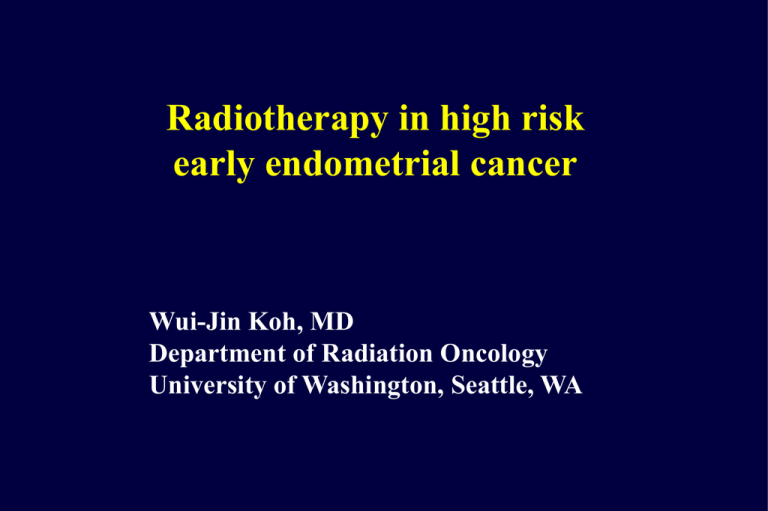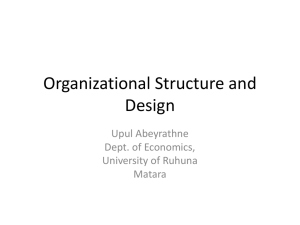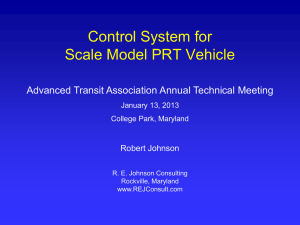Endometrial Cancer - Is Adjuvant RT Necessary?
advertisement

Radiotherapy in high risk early endometrial cancer Wui-Jin Koh, MD Department of Radiation Oncology University of Washington, Seattle, WA Endometrial cancer case 64 yo, diet-controlled DM, BMI=35 PMB EMB = Gr2 endometriod adenocarcinoma CXR neg, CBC/BMP WNL, pt deemed surgical candidate Vaginal hysterectomy + BSO Path – 3 cm tumor, LVSI+, 75% myoinvasion – Cul-de-sac washings negative Case from 3/07 Int Gynecologic Cancer Society tumor board, submitted by Dr Karl Podratz www.igcs.org Endometrial cancer case (64 yo, Gr 2, LVSI+, 75% invasion) Would you consider the patient cancer to be – Low risk? – Intermediate risk? – High risk? Endometrial cancer case (64 yo, Gr 2, LVSI+, 75% invasion) What further therapy would you recommend? – Observation – Vaginal brachytherapy – External radiation +/- brachytherapy – Chemotherapy – Chemotherapy and radiation – Surgical staging including retroperitoneal LND www.igcs.org Endometrial cancer case (64 yo, Gr 2, LVSI+, 75% invasion) Systematic pelvic and PALN dissection to renal vessels No intraabdominal disease noted Path: 34 pelvic and 16 PALN harvested – All lymph nodes histologically negative – Repeat peritoneal cytology negative www.igcs.org Endometrial cancer case (64 yo, Gr 2, LVSI+, 75% invasion, 50/50 LN-) Would you now consider the patient cancer to be –Low risk? –Intermediate risk? –High risk? Endometrial cancer case (64 yo, Gr 2, LVSI+, 75% invasion, 50/50 LN-) What further therapy would you recommend? – Observation – Vaginal brachytherapy – External radiation +/- brachytherapy – Chemotherapy – Chemotherapy and radiation www.igcs.org Radiotherapy in high-risk early endometrial cancer Complex, controversial and confusing “At least Professor Vergote (IGCS president) did not ask you to talk on radiotherapy in early stage ovarian cancer” – Ted Trimble, IGCS president-elect Radiotherapy in high-risk early endometrial cancer - definitions Adjuvant RT following primary surgery – RT alone has curative potential in medically inoperable patients Early = Uterine confined (stage I/II) Adenocarcinoma, endometriod histology – Uterine papillary serous carcinoma as a distinct entity Proposed definition of ‘risk’ in EC High risk - extrauterine disease – (ie – not early stage) – Implies that treatment is needed Low risk - Stage IA all grades, IBG1, IBG2, IIA? Intermediate risk – IBG3 – All stage IC’s – Cervical stromal involvement Endometrial cancer – general observations Role of adjuvant RT in early disease – Historically overused – Current decreased trend is a good thing! – No randomized trial (n=3) has shown overall survival benefit improvement Role in pelvic control, ?PFI of chemotherapy increasing in extrauterine disease, but unproven in early disease Adjuvant RT for Uterine-confined EC Issues – Prognostic factors and definitions of risk – Extent of surgical staging – Patterns of failure after surgery – Toxicity of adjuvant therapy Intrauterine pathologic prognostic factors Grade DMI LVSI Cervical Cell stromal invasion type - papillary serous / clear cell Lower uterine segment involvement? Tumor bulk Biomolecular markers (PTEN, Her2/neu, p53…) Does surgical extent alter risk in EC? Therapeutic benefit? – Kilgore (Gynecol Oncol 1995); ASTEC 2006 Alters individual assessment and classification of risk – 1988 FIGO surgicopathologic staging – Risk assessment of clinical vs pathologic uterineconfined EC (Zaino, Cancer 1996) – The harder you look for it, the greater the sensitivity Surgical-Pathological staging considerations Without LNS, prognosis primarily based on grade and depth of myometrial invasion (DMI) Grade & DMI predicts for LN+ Patients with LN+ now upstaged to IIIC – Stage migration – 92.7% 5-yr survival for pathological Stage I cancer with no adverse risk features other than grade and myoinvasion (Morrow, Gynecol Oncol 1991) Endometrial cancer case (64 yo, Gr 2, LVSI+, 75% invasion, 3/3 LN-) Would you now consider the patient cancer to be –Low risk? –Intermediate risk? –High risk? –High intermediate risk? Role of RT in non-surgically staged EC historical analysis Aalders, Obstet Gynecol, 1980 – 540 St I pts, all received ICBT, 6000 rads – Randomized to no vs 4000 rads pelvic RT – No difference in overall survival or overall relapse – Pelvic RT decreased pelvic failure, but altered pattern of failure – ? benefit in patients with grade 3 and > 50% DMI Efficacy of RT in non-surgically staged EC historical analysis Kucera, Gynecol Oncol 1990 – Selective addition of pelvic RT to patients with high risk intrauterine features ‘equalized’ outcome to good prognostic group. Carey, Gynecol Oncol 1995 – Selective use of pelvic RT in high risk patients achieved good overall outcome. Role of RT in non-formally staged EC? Contemporary analysis PORTEC (Creutzberg Lancet 2000, Sholten IJROBP 2005) – 714 patients, ICG1, IBG2, ICG2, IBG3 – ICG3 specifically NOT included – Randomized to NAT vs 46 Gy pelvic RT – No brachytherapy – RT decreases LRF, but has no impact on survival RT not indicated in IBG2, < 60 yo – RT increases morbidity Role of RT in non-formally staged EC? PORTEC (Scholten IJROBP 2005) – Centralized path review – 134 cases ‘excluded’ based on stage IB Gr1 ‘downstaging’ – did not affect outcome – 10 yr LR failure rate: S – 14%, S+RT – 5% (p < 0.001) 73% of LRF’s were isolated vaginal – Risk factors – age ≥ 60, Gr 3, ≥ 50% myoinvasion If at least 2 of 3 risk factors present 10 yr LRF rate: S- 23.1%, S+RT – 4.6% – Late toxicity - 5 yr actuarial rates (Creutzberg, IJROBP 2001) All grades: S – 4%, S+RT – 26% (p < 0.0001) Grade 1: S- 4%, S+RT – 17% Grade 3-4: S+RT – 3% Role of RT in non-formally staged EC? “In view of the significant locoregional control benefit, radiotherapy remains indicated in Stage I endometrial carcinoma patients with high-risk features for locoregional relapse.” PORTEC – Scholton, IJROBP 2005 Role of RT in surgically staged EC? Contemporary analysis GOG 99 (Roberts, SGO 1998 abst) – 392 pathologic stage IB/IC/occult II patients, all grades – Randomized to NAT vs 50 Gy pelvic RT – No brachytherapy – Significant decrease in pelvic failures – “Use of adjunctive RT in women with intermediate risk EC decreases the risk of recurrences but has an inappreciable effect on overall survival” Role of RT in surgically staged EC? GOG 99 (Keys, Gynecol Oncol 2004) Overall survival: HR 0.86 (90% CI 0.57-1.29, p=0.56), median f/u 69 m Benefit of RT in HIR subset of GOG 99? (Keys, Gynecol Oncol 2004) “High Intermediate Risk” – Gr 2 or 3, LVSI, outer third myometrial invasion – Age > 50 and 2 of above – Age > 70 and 1 of above “Adjuvant RT in early stage intermediate risk endometrial carcinoma decreases the risk of recurrence, but should be limited to patients whose risk factors fit a high intermediate risk definition.” Role of RT in surgically staged EC? GOG 99 (Keys, Gynecol Oncol 2004) 2-yr recur-free S (n=202) 88% S+RT (n=190) 97% (p=0.007) Confined pelvic/ vaginal failure 18 3* Isolated vaginal Failure 13 2* GI comp ≥ Gr 3 1 8 * 2 of these patients refused radiotherapy Patterns of failure in early endometrial cancer undergoing surgery only– implications for treatment The majority of pelvic failures in both PORTEC and GOG 99 were isolated vaginal Are non-radiated isolated vaginal failures curable? – PORTEC – 5 yr survival 65% – GOG 99 – 5/13 DOD on preliminary evaluation Predictors of vaginal relapse – Gr 3 histology, LVSI+ (Mariani, Gyn Oncol 2005) Can adjuvant vaginal brachytherapy address potential vaginal failures, and improve the therapeutic index? IVBT as adjuvant for uterine-confined EC - intermediate risk Chadha et al, Gynecol Oncol 1999 – 38 pathologic stage I EC, full surgical staging – IB/G3 - 12, IC/G1 - 14, IC/G2 - 9, IC/G3 - 3 – IVBT 7 Gy x 3 @ 0.5 cm – 5 yr DFS 87%, 5 yr OS 93% – No vaginal/pelvic failure, 3 failed in upper abd – No significant late morbidity IVBT as adjuvant for uterine-confined EC - intermediate risk Ng et al, Gynecol Oncol 2000 – 77 pathologic stage I EC, full surgical staging – IBG3 - 17, ICG1 - 10, ICG2 - 33, ICG3 - 17 – IVBT 60 Gy LDReq to upper 2 cm mucosa – 5 yr DFS = 82%, 5 yr OS = 94% – 11 recurrences 3 distant, 1 pelvis 7 vagina (5 lower 2/3) – No significant late complications IVBT as adjuvant for uterine-confined EC - intermediate risk Ng et al, Gynecol Oncol 2001 – 15 pathologic stage II(occ) EC, surgically staged – IIA - 5, IIB - 10 (G1 - 5, Gr 2 - 8, Gr 3 - 2) – IVBT 60 Gy LDReq to upper 2 cm mucosa – Median f/u = 36 months – No recurrences – No significant complications Cost of therapy IVBT less costly than external beam RT Patient convenience Ancillary costs – Time to recovery – Time away from employment IVBT as adjuvant for uterine-confined EC Vaginal failures occur in 8 - 15% (with identifiable risk factors) – Despite surgery! IVBT addresses primary site of preventable failure – Especially in surgically staged patients PORTEC 2 – ext RT vs IVBT IVBT as adjuvant for uterine-confined EC Effective in preventing vaginal relapse – When applied appropriately – Prevention is better than salvage Well-tolerated If disease volume at risk is beyond the ‘reach’ of IVBT, local-regional therapy alone may be insufficient (!?) Role of external RT in EC? Documented High extrauterine disease risk of extrauterine disease – Incompletely staged cases with significant intrauterine risk factors – ‘greatest-risk’ subset of early EC, independent of surgical staging IC Gr3, IIB Contemporary imaging tools in RT planning CT with digital subtraction RA AB IMA CIB Circ iliac Contemporary RT imaging/planning tools PET CT reconstruction Rose, 1997 Mundt, U Chicago RT isodose distribution 4-field pelvic ‘box’ PTV IMRT 100% PTV 70% Courtesy: Arno Mundt, MD 100% 70% Dose-volume histogram analysis Conv IMRT Courtesy: Arno Mundt, MD Incompletely staged EC 70+% of endometrial cancer cases in the US are NOT operated on by Gyn Oncologists Radiologic Consider Imaging surgical staging – If you agree that you would not give pelvic RT if no LN involvement is found Table 1. Inciden ce of pelvic lymph node involve ment as a function of tumor grade and myometrial invasion in clini cal stage I endome trial cancer – results of a prospective su rgicopathologic s tudy (Creasman et al, 1987) Grade G1 G2 G3 Endo metrium only 0/44 (0%) 1/31 (3%) 0/11 (0%) Inner 1/3 3/96 (3%) 7/131 (5%) 5/54 (9%) Middl e 1/3 0/22 (0%) 6/69 (9%) 1/24 (4%) Deep 1/3 2/18 (11%) 11/57 (19%) 22/64 (34%) Depth of Invasion Numerator fractional depth of invasion is defined as follows: Endometrium only = 0; inner 1/3 = 1; 1/3 to 2/3 = 2; greater than 2/3 = 3. Tumor grade expressed as 1, 2, or 3. Koh et al, 2001 (based on data from Creasman et al, 1987) Incompletely staged EC - Adjuvant RT? Likelihood of LN+ – LN+% = 3 x Grade X DMI (in fractional thirds) – analysis from Creasman, Cancer 1987 Cure for pathologic stage III EC with PRT ~ 65% – Greven, Cancer 1993 Complication 0.65 rate for RT s/p TAH ~ 5% x LN+% > 5% ---> LN+% > 8% to justify PRT? 1999 NCCN guidelines for surgically staged EC adjuvant RT Grade 1 St IA Obs IB Obs IC Obs / ICBT / PRT +/- ICBT IIA Obs / ICBT* IIB PRT + ICBT * if DMI ≤ 50% 2 Obs 3 Obs / ICBT / PRT +/- ICBT Obs / ICBT / PRT +/- ICBT ICBT / PRT +/- ICBT PRT +/- ICBT PRT +/- ICBT ICBT* PRT + ICBT PRT + ICBT PRT + ICBT www.nccn.org 2001 NCCN guidelines for surgically staged early EC - adjuvant RT Grade 1 St IA Obs 2 Obs 3 Obs / ICBT / PRT +/- ICBT Obs / ICBT / PRT +/- ICBT IB Obs / ICBT IC Obs / ICBT / PRT +/- ICBT Obs / ICBT / PRT +/- ICBT Obs / ICBT / PRT +/- ICBT IIA Obs / ICBT* Obs / ICBT* PRT + ICBT IIB PRT + ICBT PRT + ICBT PRT + ICBT * if DMI ≤ 50% PRT +/- ICBT www.nccn.org 2006 NCCN guidelines for surgically staged EC adjuvant RT A 3-dimensional table!! – Incorporates traditional grade and depth of invasion – Adds consideration of patient age, LVSI, tumor size 2006 NCCN guidelines for surgically staged early EC - adjuvant RT Grade 1 St IA Obs 2 Obs 3 Obs / ICBT / PRT +/- ICBT Obs / ICBT / PRT +/- ICBT IB Obs / ICBT IC Obs / ICBT / PRT +/- ICBT Obs / ICBT / PRT +/- ICBT Obs / ICBT / PRT +/- ICBT IIA Obs / ICBT PRT +/- ICBT Obs / ICBT PRT +/- ICBT ICBT/ PRT +/- ICBT IIB PRT + ICBT PRT + ICBT PRT + ICBT ICBT / PRT +/- ICBT www.nccn.org Adjuvant RT for early endometrial cancer – metaanalysis and systematic reviews Cochrane Review (Kong et al, Ann Oncol 2007) – Pelvic RT leads to a 72% RR reduction in locoregional relapses – Trend towards benefit in survival for patients with multiple risk factors (eg Gr3 and stage IC) – Inherent risk of added toxicity Ontario program in evidence-based care – Gyn Cancer Disease Site Group practice guidelines March 2006 (Lukka et al www.cancercare.on.ca/pdf/pebc4-10f.pdf) – Regardless of surgical staging, external adjuvant RT Is recommended for ICG3 Is NOT recommended for IA/IB G1G2 Is a reasonable option for IC G1G2, IA/IB G3 Adjuvant ext pelvic RT for EC - circa 1984 Grade 1 St IA IB IC IIA IIB University of Washington, Seattle 2 3 Adjuvant ext pelvic RT for EC - circa 1990 surgically staged Grade 1 St IA IB IC IIA IIB University of Washington, Seattle 2 3 Adjuvant RT for EC - Y2K Surgically staged Grade 1 2 3 St IA IB IC IIA IIB ICBT ICBT? ICBT ICBT ICBT ICBT University of Washington, Seattle Adjuvant RT for EC - 2007 Surgically staged Grade 1 2 3 St IA IB ICBT IC ICBT? ICBT IIA ICBT ICBT IIB ICBT University of Washington, Seattle ICBT Uterine confined EC - who is at risk for extrapelvic relapse? In GOG 99 – HIR (Keys, Gynecol Oncol 2004) – > 2/3 DMI, Gr 2 or 3, LVSI+ – Age > 50 & 2 of the above – Age > 70 & 1 of the above 42% of failures in S only group were extrapelvic 77% of failures in S+RT group were extrapelvic IC Gr3 endometrial adenocarcinoma – ‘PORTEC registry’ (Creutzberg JCO 2004) 99 pts with ICG3 treated with RT – Compared to 345 pts on phase III trial who actually received RT – 5 yr LRF rate: ICG3 – 14%, PORTEC pts – 3% – 5 yr DM rate: ICG3 – 31% Uterine confined endometrial cancer – summary Surgical staging has made a major impact – Stage migration – Therapeutic benefit? – Tailored adjuvant therapy Most patients do not need adjuvant therapy For most intermediate risk EC considered for adjuvant RT, IVBT may be sufficient For those at ‘greatest risk’, external RT alone may be insufficient as sole adjuvant therapy – ? ChemoRT - RTOG 9708: Greven, Gynecol Oncol 2006 Uterine confined endometrial cancer – summary ‘Risk’ exists on a continuum, but our categorization of risk is based on discrete, and sometimes arbitrary measures Majority do not need adjuvant therapy – Start with a minimalist mindset and evaluate each case individually – No “one size fits all” – Understand personal and historical biases Educate the patient and the care providers Assess level of risk based on careful assessment of all available surgicopathologic features – Multidisciplinary interaction and pathology review







